The production of Other Crops in Cagayan declined by -3.17 percent in 2024, lower than the growth recorded during the same period in 2023. The province's total volume of production reached 370,177.44 metric tons (MT), a decrease of 12,100.47 MT from its 2023 level of 382,277.91 MT.
The overall decline in production was primarily attributed to a -1.71 percent drop in Non-Food Industrial Crops, along with a -2.75 percent downturn in Fruit Crops, and -9.78 percent decline in Vegetables and Root Crops, relative to the same period of the previous year (Table 1).
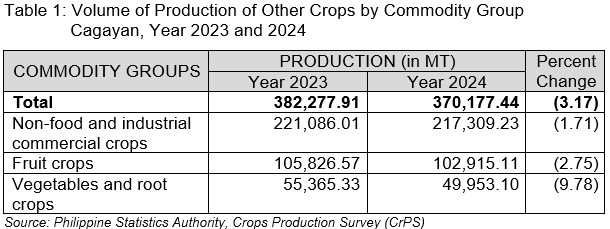
Of the 370,177.44 MT total Other Crops produced in Cagayan in 2024, 58.70 percent was recorded for Non-food and industrial commercial crops. This is followed by Fruit crops, which constituted 27.80 percent of the overall output. Meanwhile, Vegetables and root crops contributed the smallest least share, accounting for only 13.49 percent of the total production. (Figure 1)
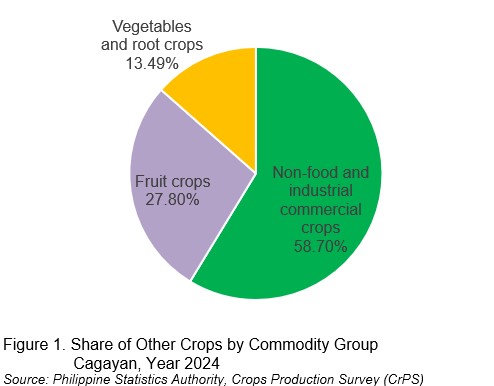
TOP FIVE MAJOR OTHER CROPS IN CAGAYAN
Among the province’s top five major Other Crops, Sugarcane recorded the highest production in 2024, reaching 128,389.10 MT an uptick of 5.84 percent from the previous year. Banana followed with 64,027.59 MT but recorded a -2.04 percent decrease compared in 2023.
Coconut (w/ husk) and Pineapple production reached 43,400.92 MT and 18,791.41 MT, exhibiting a downward trend rate of -6.46 percent and -4.70 percent, respectively. Meanwhile, Cassava, fresh tubers, which ranked fifth, recorded 8,647.47 MT, reflecting a -7.22 percent decrease from the previous year’s production. (Table 2)
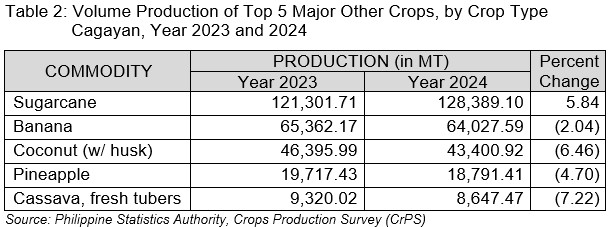
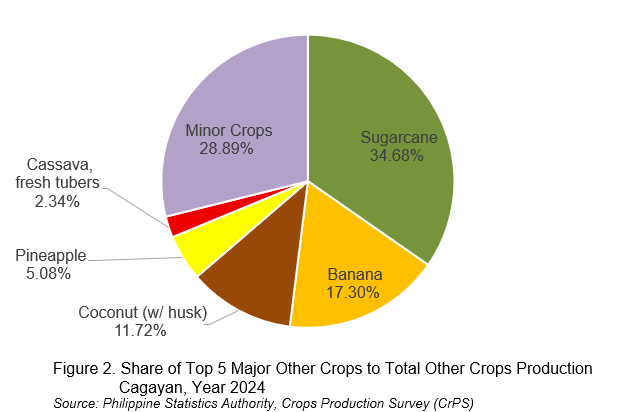
Among the province’s top five major Other Crops, Sugarcane had the largest share, accounting for 34.68 percent of Cagayan's total other crops production in year 2024. This was followed by Banana at 17.30 percent, Coconut (w/ husk) at 11.72 percent, Pineapple at 5.08 percent and Cassava, fresh tubers at 2.34 percent. Meanwhile, Minor Crops collectively accounted for 28.89 percent of the total other crops production in the province during the same period. (Figure 2)
VOLUME OF PRODUCTION BY SUB-COMMODITY GROUP
A. Non-food and industrial commercial crops (NFICCs)
Among the province’s selected NFICCs, Sugarcane recorded the highest production in 2024, reaching 128,389.10 MT—an uptick of 5.84 percent from the previous year. Coconut (w/ husk) followed with 43,400.92 MT, reflecting a -6.46 percent decline compared to the same period in 2023.
Rice Hay production reached 47,500.18 MT, showing a -14.96 percent decrease. Nipa Leaves production reached 3,551.50 MT, marking an increase of 1.75 percent from the previous. Likewise, Green Corn Stalk, which ranked fifth, recorded 1,897.75 MT, reflecting a 10.88 percent increase from the previous year. (Table 3)
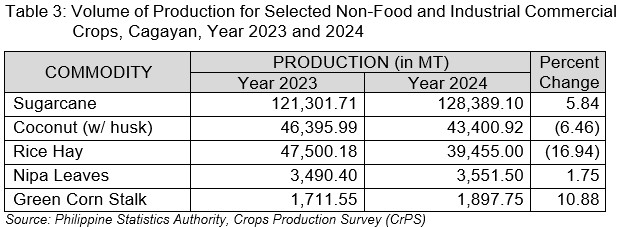
B. Fruit crops
Among selected Fruit crops, Banana, Pineapple, Watermelon and Calamansi exhibited declining production trends during the period under review. Banana production reached 64,027.59 MT, indicating a -2.04 percent decrease relative to the previous year. Pineapple production fell by -4.70 percent, recorded at 18,791.41 MT, while Watermelon production dropped by -6.53 percent to 6,350.65 MT. Calamansi production also registered a -4.09 percent reduction, reaching 2,386.34 MT.
By comparison, Mango production increased by 4.69 percent, arrive at 7,482.99 MT compared to the previous year's output. (Table 4)
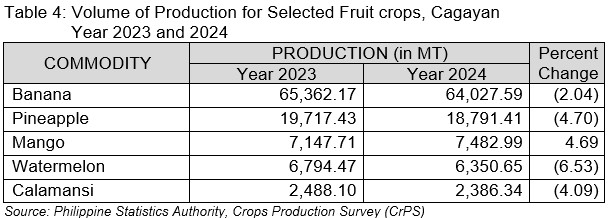
C. Vegetables and root crops
Among selected Vegetables and root crops, Cassava (fresh tubers) production declined to 8,647.47 MT, representing a -7.22 percent year-on-year decrease. Gabi (Taro) production fell by -10.99 percent, totaling 5,689.51 MT, Similarly, Sitao (Stringbeans) and Eggplant recorded negative growth rates of -7.53 percent and -2.92 percent, reaching 3,563.51 MT and 6,030.90 MT, respectively. Meanwhile, Camote (Sweet potato) posted a -5.41 percent, binging the total output down to 3,112.22 MT. (Table 5)
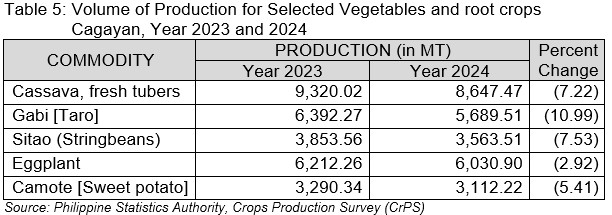
Technical Notes:
The Crops Production Survey (CrPS) is one of the major agricultural surveys conducted by the Philippine Statistics Authority (PSA). This survey aims to generate estimates on volume of production, area planted/harvested, number of bearing trees/hills/vines, and farmgate prices for crops other than palay and corn at the national and sub-national levels.
The general purpose of the CrPS is to generate estimates on the volume of production, area planted/harvested, number of bearing trees/hills/vines, and farmgate prices for crops other than palay and corn at the national and sub-national levels.
The CrPS is conducted in all provinces, excluding the National Capital Region, based on its Philippine Standard Geographic Code (PSGC) classification. The commodity coverage varies by province based on the availability in terms of planting and seasonality.
The reference period for production, area planted/harvested, number bearing trees/hills/vines, are quarterly, last 10 days of the month for farmgate prices and while for the information on standing crops and expected area planted/harvested and bearing trees/hills/vines is for the succeeding months/quarters.
Data Items Gathered in the Survey
• Geographic Identification
• Sample Identification
• Status of Operation of the Household
• Information on Crops Production (crops harvested, unit of measure used in harvesting
the crop, quantity harvested, equivalent weight in kilogram per unit of measure)
• Information on Area Planted/Harvested
• Information on Total Number of Bearing Trees/Hills/Vines
• Information on Actual Number of Bearing Trees/Hills/Vines Harvested
• Assessment of Households Production
• Reason for Higher/Lower Production
• Information on Standing Crop (trees/hills/vines that previously borne fruits and are
expected to bear fruits for permanent crops and expected area to be harvested in the
next three months for temporary crops).
• Information on Farmgate Prices (crops sold, trading date, trading location,
unit of measure used in selling the crop, equivalent weight in kilogram per unit
of measure, price per unit of measure, quantity sold in unit of measure,
total sales of the crop, total marketing cost, transport cost, and other marketing cost)
• Assessment of Households Farmgate Price
• Reason/s for Higher/Lower Farmgate Price

